Stephen Hong Sohn's Blog, page 8
September 18, 2024
A Review of Fonda Lee’s Jade City (Orbit, 2017)
![[personal profile]](https://i.gr-assets.com/images/S/compressed.photo.goodreads.com/hostedimages/1491408111i/22407843.png) lsobiesk
lsobiesk
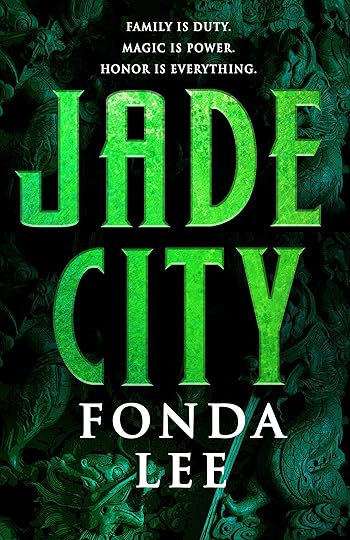
Written by Stephen Hong Sohn
Edited by Lizzy Sobiesk
I’ve been meaning to read this entire series for quite some time. Recently, a former graduate student of mine mentioned that she was really into this particular series, so I figured I would try to start it again. To be honest, I crashed out of the first in this series once, so this time I told myself that I would be patient, and I was rewarded (and my student’s estimation of the immersive quality of the series was more than correct)! Let’s let the marketing description give us some background on the novel: “Jade is the lifeblood of the island of Kekon. It has been mined, traded, stolen, and killed for — and for centuries, honorable Green Bone warriors like the Kaul family have used it to enhance their magical abilities and defend the island from foreign invasion. Now, the war is over and a new generation of Kauls vies for control of Kekon's bustling capital city. They care about nothing but protecting their own, cornering the jade market, and defending the districts under their protection. Ancient tradition has little place in this rapidly changing nation. When a powerful new drug emerges that lets anyone — even foreigners — wield jade, the simmering tension between the Kauls and the rival Ayt family erupts into open violence. The outcome of this clan war will determine the fate of all Green Bones — and of Kekon itself.”
So, Lee shifts from the more science fictional YAs that I’ve read from her (Exo, Crossfire) and moves into the realm of high fantasy. You might call this one silkpunk, and certainly, it follows the trend of many Asian-inspired fantasies I’ve seen come out over the last decade (perhaps the subject of a future critical book by someone). This novel follows three children of a major clan (the Kauls) in Kekon, who are in a fight with the Ayt clan over the control of jade and various territories within Kekon itself. Lee does a great job of toggling our attentions amongst these characters as well as a 4th (Anden) who is a kind of adopted brother of the major three characters. Lan is the de facto leader of the clan (called the Pillar), while his brother Helo is his strongarm (called the Horn). An aging man who is the kind of advisor, Doru, is the final major player (called a Weather Man). Lan is killed about a third of the way through the novel, leading to a major succession issue. Helo becomes the Pillar, while he convinces his sister, Shae, who had sworn off jade and the clan, to become his Weather Man. Doru is forced out, while Helo appoints one of his major allies to become Horn. The conclusion makes clear that Helo will do anything to protect the clan; he is ultimately able to (with the help of Anden) achieve a form of revenge by killing Ayt’s Horn. In the wake of this event, Anden swears off jade, worrying that it will lead to madness (which runs in his family), while Helo is seriously injured but eventually recovers. The conclusion of this novel ultimately sets up a larger issue over the trading of jade, which is becoming more and more international. The first installment clearly shows Fonda Lee’s mastery of the high fantasy genre. We get enough of the magic in the way that jade is wielded through many different abilities, on the one hand, while the clan power dynamics certainly make for lively plotting mechanics, on the other. The only drawback to such a sprawling novel is that you are certain to find specific plots and characters more engaging than others. I found myself, for instance, following Shae’s and Anden’s sections more intently than any other. Despite such minor quibbles, I quickly moved on to the second installment!
Buy the Book Here
 comments
comments
September 16, 2024
A Review of Rosalie M. Lin’s Daughter of Calamity (St. Martin’s Press, 2024)
![[personal profile]](https://i.gr-assets.com/images/S/compressed.photo.goodreads.com/hostedimages/1491408111i/22407843.png) lsobiesk
lsobiesk

Written by Stephen Hong Sohn
Edited by Lizzy Sobiesk
Ah, I’ve been trying to catch up on more Asian American speculative fiction over the summer. Rosalie M. Lin’s debut, Daughter of Calamity (St. Martin’s Press, 2024), caught my eye because it looked to be something like a low fantasy. In any case, let’s let the marketing description whet our speculative appetites: “Jingwen spends her nights as a showgirl at the Paramount, one of the most lavish clubs in Shanghai, competing ruthlessly to charm wealthy patrons. To cap off her shifts, she runs money for her grandmother, the exclusive surgeon to the most powerful gang in the city. A position her grandmother is pressuring her to inherit… When a series of dancers are targeted—the attacker stealing their faces—Jingwen fears she could be next. And as the faces of the dancers start appearing on wealthy foreign socialites, she realizes Shanghai's glittering mirage of carefree luxury comes at a terrible price. Fighting not just for her own safety but that of the other dancers—women who have simultaneously been her bitterest rivals and only friends—Jingwen has no choice but to delve into the city's underworld. In this treacherous realm of tangled alliances and ancient grudges, silver-armed gangsters haunt every alley, foreign playboys broker deals in exclusive back rooms, and the power of gods is wielded and traded like yuan. Jingwen will have to become something far stranger and more dangerous than her grandmother ever imagined if she hopes to survive the forces waiting to sell Shanghai's bones.”
Lin’s fictional world reminds me a bit of Nghi Vo’s work in the sense that the magic and the speculation seem to be a part of the fabric of everyday reality. I absolutely loved how Lin was able to meld the 30s Shanghai with enchanted elements. Jingwen’s grandmother is a kind of surgeon who works for the highest bidder, including gangs and others who come with her for requests to do various suturing. One of her most popular operations is one in which human arms are taken out and replaced with metal ones. The most gothic element is the way that dancers are being targeted: their lips or their eyes might suddenly disappear. Jingwen eventually comes into contact with a rich American businessman at the dance hall. This chance encounter leads her into the major elements of the plot. Readers come into a world in which magical fungi produce visions and allows mortals to commune with the gods. Lin is also very clearly committed to a kind of speculative feminism. Though Jingwen, at first, sees her fellow dancers as rivals, by the novel’s end, her tune has changed significantly. She realizes that these women are not only artists, but worthy of protection, and thus her quest plot revolves around how she can get justice for these women and change the future for them as an entire grouping. The importance of gods to this text also does bring to mind Kuang’s Poppy War trilogy, and readers of that particular series will find much to enjoy in this one, especially since Lin’s fictional world is fully grounded in referential contexts connected to our reality.
Buy the Book Here
 comments
comments
September 12, 2024
A Review of Anton Hur’s Toward Eternity (HarperVia, 2024)
![[personal profile]](https://i.gr-assets.com/images/S/compressed.photo.goodreads.com/hostedimages/1491408111i/22407843.png) lsobiesk
lsobiesk
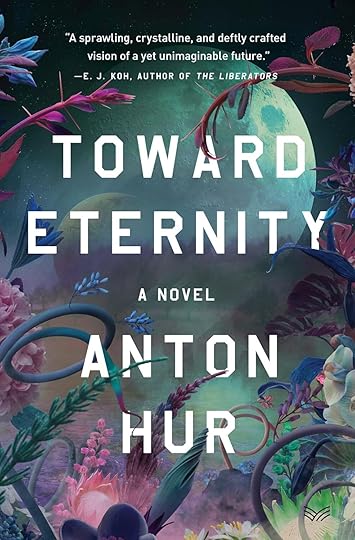
Written by Stephen Hong Sohn
Edited by Lizzy Sobiesk
Anton Hur’s Toward Eternity (HarperVia, 2024) was a real surprise! I really enjoyed Hur’s structural conceit in this novel as well as the narrative perspective shifts. Here is the official marketing description: “In a near-future world, a new technological therapy is quickly eradicating cancer. The body’s cells are entirely replaced with nanites—robot or android cells which not only cure those afflicted but leaves them virtually immortal. Literary researcher Yonghun teaches an AI how to understand poetry and creates a living, thinking machine he names Panit, meaning Beloved, in honor of his husband. When Yonghun—himself a recipient of nanotherapy—mysteriously vanishes into thin air and then just as suddenly reappears, the event raises disturbing questions. What happened to Yonghun, and though he’s returned, is he really himself anymore? When Dr. Beeko, the scientist who holds the patent to the nanotherapy technology, learns of Panit, he transfers its consciousness from the machine into an android body, giving it freedom and life. As Yonghun, Panit, and other nano humans thrive—and begin to replicate—their development will lead them to a crossroads and a choice with existential consequences. Exploring the nature of intelligence and the unexpected consequences of progress, the meaning of personhood and life, and what we really have to fear from technology and the future, Toward Eternity is a gorgeous, thought-provoking novel that challenges the notion of what makes us human—and how love survives even the end of that humanity.”
What this overview does not articulate is the fact that the novel is told primarily in the first person from a variety of different storytellers across time. The opening of the novel really begins us in the frame of a detective fiction, with Yonghun’s disappearance, but once that mystery is solved, the narrative takes some radical turns. We begin to see that the nanites and how they operate are far more complicated than the creators originally intended. The other element that I really appreciated is how Hur uses a structural conceit to bolster the narrative progression. At one point, there is a notebook that is essentially moving between characters, and they are tasked with generating their personal archive. The final sections of the novel are mind-blowing in terms of the ambition and the general shift in the tonality. Originally, the novel seemed much more mundane and personal, but the stakes became global and even interplanetary (mild spoiler here) by the conclusion. This novel certainly contains some resonances with other science fictions. Comparisons with The Matrix and The Terminator are apt and undeniable, but I actually think that the trappings of genre are a kind of ornament over the larger universal themes that you find in fiction, such as love and grief. In that respect, I actually would put this novel more in line with something like Madeleine L’Engle’s A Wrinkle in Time with respect to the emotional core that propels characters forward. A very auspicious debut from a writer with a lot of interesting ideas. Fans of Ishiguro’s Klara and the Sun and other fictions related to artificial intelligence will be very pleased to dive in.
Buy the Book Here
 comments
comments
September 10, 2024
A Review of Salman Rushdie’s Knife (Random House, 2024)
![[personal profile]](https://i.gr-assets.com/images/S/compressed.photo.goodreads.com/hostedimages/1491408111i/22407843.png) lsobiesk
lsobiesk
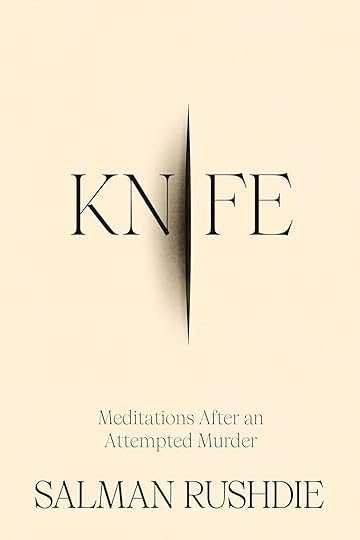
Written by Stephen Hong Sohn
Edited by Lizzy Sobiesk
It’s been a good long time since I’ve read some Salman Rushdie. Let’s be clear. Over the years, I have been meaning to read the latest novel or what have you, but what is it they say about best intentions? But I digress! The funny thing is that of course Rushdie is known for his fiction, and here I am reading this memoir. In my defense, I have been on a creative nonfictional kick for whatever reason. Let’s let the marketing description do some work for us: “On the morning of August 12, 2022, Salman Rushdie was standing onstage at the Chautauqua Institution, preparing to give a lecture on the importance of keeping writers safe from harm, when a man in black—black clothes, black mask—rushed down the aisle toward him, wielding a knife. His first thought: So it’s you. Here you are. What followed was a horrific act of violence that shook the literary world and beyond. Now, for the first time, and in unforgettable detail, Rushdie relives the traumatic events of that day and its aftermath, as well as his journey toward physical recovery and the healing that was made possible by the love and support of his wife, Eliza, his family, his army of doctors and physical therapists, and his community of readers worldwide. Knife is Rushdie at the peak of his powers, writing with urgency, with gravity, with unflinching honesty. It is also a deeply moving reminder of literature’s capacity to make sense of the unthinkable, an intimate and life-affirming meditation on life, loss, love, art—and finding the strength to stand up again.”
What you have to love about Rushdie’s writing is that it’s always playful. When reading Shame or Midnight’s Children or Fury, there is always something a little bit whimsical about Rushdie’s writing, and it is preserved in the realm of creative nonfiction as well. Despite the gravity of the memoir’s circumstances, Rushdie always maintains a kind of sly humor that has consistently undergirded the writings I’ve read. The memoir is, not surprisingly, very easy to read, quite immersive, and can be finished quickly. Each chapter sets up a different aspect of narrative involving Rushdie’s experiences before, during, and then after the knife attack. I appreciated most how unflinching Rushdie was in describing the lengthy and excruciating recovery process. Rushdie must come to terms with a major acquired physical impairment, as he will never be able to see out of one of his eyes. So serious are his injuries that many of his caretakers are ultimately surprised when he leaves the hospital. The other element that’s intriguing is Rushdie’s desire to understand his attacker. His assailant is just given the name “A,” and this moniker proves to be an important way by which Rushdie attempts to minimize his centrality. At the same time, “A” becomes a site of indefinite speculation, precisely because Rushdie’s introspective self seeks to find some sense of why this individual thought that this path of action was the best one to take. In this respect, the memoir contains a strong philosophical impulse that resonates across its long arc. Finally, and perhaps, most important, is the way by which Rushdie explores his burgeoning relationship to his partner, Eliza, who not only becomes his caretaker but also his protector. It is clear that despite the many dangers that present themselves in this journey, the two find a way to overcome numerous obstacles, thus leading this memoir to be as much about love as it is about the attack. Highly recommended for fans of Rushdie and of the creative nonfictional form.
Buy the Book Here
 comments
comments
September 5, 2024
A Review of Grace Cho’s Tastes Like War (Feminist Press, 2021)
![[personal profile]](https://i.gr-assets.com/images/S/compressed.photo.goodreads.com/hostedimages/1491408111i/22407843.png) lsobiesk
lsobiesk
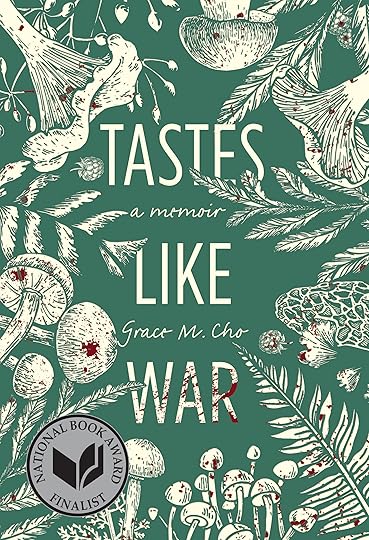
Written by Stephen Hong Sohn
Edited by Lizzy Sobiesk
I really had to wait to read this novel. It took a lot out of me to write Minor Salvage; it was emotionally difficult work, especially because it was perhaps the first time I had moved into a more autobiographical register when writing an academic scholarly study. There are a lot of personal stories that surround the scholarship of academics, and such is also the case with the work of Grace Cho, whose first book, Haunting the Korean Diaspora, is a masterful study of gender, transnationalism, psychoanalytic theory, and the Korean War. Throughout that book, Cho makes clear that there are personal undercurrents pushing the work forward, but it is not until Cho publishes her second work, the creative nonfiction Tastes Like War, that we see how deeply this background impacted her scholarship. Let’s let the official marketing description do some contextualizing for us: “Grace M. Cho grew up as the daughter of a white American merchant marine and the Korean bar hostess he met abroad. They were one of few immigrants in a xenophobic small town during the Cold War, where identity was politicized by everyday details—language, cultural references, memories, and food. When Grace was fifteen, her dynamic mother experienced the onset of schizophrenia, a condition that would continue and evolve for the rest of her life. Part food memoir, part sociological investigation, Tastes Like War is a hybrid text about a daughter’s search through intimate and global history for the roots of her mother’s schizophrenia. In her mother’s final years, Grace learned to cook dishes from her mother’s childhood in order to invite the past into the present, and to hold space for her mother’s multiple voices at the table. And through careful listening over these shared meals, Grace discovered not only the things that broke the brilliant, complicated woman who raised her—but also the things that kept her alive.”
I have to admit that I had to read this creative nonfictional work, which is described as a “hybrid text,” in fits and starts, given the gravity of the subject matter. What was ultimately most striking to me about this particular work was that it illuminates the aforementioned background of so many academic studies. For Cho, Haunting the Korean Diaspora wasn’t just scholarship, it was also partly an autobiographical experience. This book pays incredible attention to Cho’s mother, her struggles and her complexly lived life, as well as all those who end up in her mother’s orbit. The care with which Cho archives the phases in her mother’s life is especially affecting, and we absolutely see the profound ways in which traumas cross oceans and generations through Cho’s brilliant writings.
Buy the Book Here
 comments
comments
September 3, 2024
A Review of Tommy Orange’s Wandering Stars (Knopf, 2024)
![[personal profile]](https://i.gr-assets.com/images/S/compressed.photo.goodreads.com/hostedimages/1491408111i/22407843.png) lsobiesk
lsobiesk

Written by Stephen Hong Sohn
Edited by Lizzy Sobiesk
At AALF, we occasionally cast light on other BIPOC writings. Such is also the case here with our review of Tommy Orange’s Wandering Stars (Knopf, 2024). This novel is the follow-up to Orange’s There There, and some have called this one both a prequel and a sequel. I didn’t understand what was going on until I began reading the work. The first half gives us the prequel element, while the second half returns us to characters that appeared in There There. Let’s let the marketing description do some work for us at this point: “Colorado, 1864. Star, a young survivor of the Sand Creek Massacre, is brought to the Fort Marion prison castle, where he is forced to learn English and practice Christianity by Richard Henry Pratt, an evangelical prison guard who will go on to found the Carlisle Indian Industrial School, an institution dedicated to the eradication of Native history, culture, and identity. A generation later, Star’s son, Charles, is sent to the school, where he is brutalized by the man who was once his father’s jailer. Under Pratt’s harsh treatment, Charles clings to moments he shares with a young fellow student, Opal Viola, as the two envision a future away from the institutional violence that follows their bloodlines. In a novel that is by turns shattering and wondrous, Tommy Orange has conjured the ancestors of the family readers first fell in love with in There There—warriors, drunks, outlaws, addicts—asking what it means to be the children and grandchildren of massacre. Wandering Stars is a novel about epigenetic and generational trauma that has the force and vision of a modern epic, an exceptionally powerful new book from one of the most exciting writers at work today and soaring confirmation of Tommy Orange’s monumental gifts.”
This description is really interesting because it directly references the conception of epigenetics, which is a way of thinking about how trauma can be inherited and acted out in certain ways. The early generations in this text often turn to drugs—whether alcohol or derivatives of morphine—in order to deal with the various oppressions they may face (and they are legion). By the time readers are moved back into the contemporary period, we begin to see exactly why characters might be making similar choices to characters in the past. Another intriguing element is that Orange really pushes himself aesthetically. He rarely uses the same narrative perspective for a given character’s storyline. He shifts from first, third, and occasionally even second person in order to breathe life into this multigenerational tale. At first, I was a little bit underwhelmed by the disjunction between the first and second halves of the novel, but as I thought about it longer, I began to understand that recovering the past, in some cases, wouldn’t be possible. Indeed, Orange leaves his implied readers to confront the fact that characters in the fictional world would have benefited from the knowledge of what their ancestors had experienced, but the fact that such knowledge is fragmented at best means that they are left to grapple with major holes in their identities and genealogies. Thankfully, Orange (and perhaps the designers of this book) provide a nifty family tree that helped me navigate the multiple shifts, especially early in the novel. Finally, there is one character that I was so glad managed to retain his presence in this text. Many characters disappear, some never to be seen again, so Orange does give us this one salve, a sense that the future, however tenuous, may yet still be one in which a family might endure.
Buy the Book Here
 comments
comments
August 28, 2024
A Review of Tracy O’Neill’s Woman of Interest (HarperOne, 2024)
![[personal profile]](https://i.gr-assets.com/images/S/compressed.photo.goodreads.com/hostedimages/1491408111i/22407843.png) lsobiesk
lsobiesk
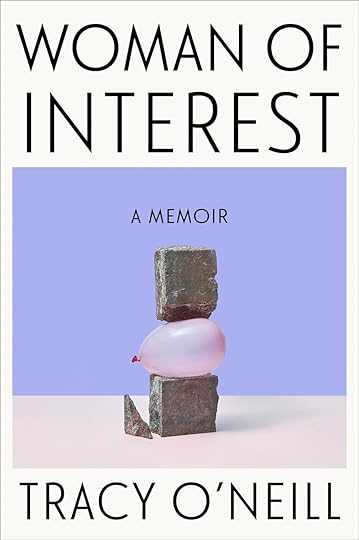
Written by Stephen Hong Sohn
Edited by Lizzy Sobiesk
Well, Tracy O’Neill’s Woman of Interest (HarperOne, 2024) is a gut punch. Unfortunately, as my free time has dropped and my responsibilities as an academic have grown, my coverage of Asian American literature has increasingly waned. Such is the case with O’Neill, who is the author of two previous novels, which I haven’t had a chance to read. I must try to rectify this oversight soon! In any case, let’s let the official marketing description provide us with some key information: “In 2020, Tracy O’Neill began to rethink her ideas of comfort and safety. Just out of a ten-year relationship and thirtysomething, she was driven by an acute awareness that the mysterious mother she’d never met might be dying somewhere in South Korea. After contacting a grizzled private investigator, O’Neill took his suggested homework to heart when he disappeared before the job was done, picking up the trail of clues and becoming her own hell-bent detective. Despite COVID-19, the promise of what she might discover—the possibility that her biological mother was her kind of outlaw, whose life could inspire her own—was too tempting. Written like a mystery novel, Woman of Interest is a tale of self-discovery and fugitivity from convention that features a femme fatale of unique proportions, a former CIA operative with a criminal record, and a dogged investigator of radical connections outside the nuclear family. O’Neill gorgeously bends the detective genre to her own will as a writer, stepping out of the shadows of her own self-conception to illuminate the hopes of the woman of interest she is both chasing and becoming.”
So, the disappearance of the private investigator is sort of a red herring, and here I will have to provide my spoiler warning. Look away unless you want to find out more about the content of the memoir! As I mentioned, the red herring issue is that the private investigator does disappear for a bit, but he does return, giving O’Neill key information and a contact that does help her find out where her mother might be. What I was struck by was O’Neill’s prose. I honestly found it syntactically very strange, but because it didn’t flow for me, I slowed down and the reading experience became ultimately more immersive as I altered my pace. What I love about this work is that it is incredibly unsentimental and lacks any significant closure. O’Neill is not the first to write this kind of memoir. You’ll find variations of it, with various outcomes and tonalities. Check out the work of Jane Jeong Trenka, Jenny Heijun Wills, Nicole Chung, but the combination of her writing style and the rawness of the content serves to make this work one to remember and certainly one to check out. I think one of the key moments that crystallizes O’Neill’s willingness to get in the dirt is when she conveys what happens when she returns from her journeys in Korea: she finds that her residence is filled with dog vomit. The one assigned to the caretaking had apparently not done the best job, but O’Neill doesn’t shy away from this type of detail, which is part and parcel of the ways that she lets readers sit with her in discomfort, and discomfort is probably the affectual state that best describes what we witness as we go along with for this complicated ride. As someone who has increasingly read more and more memoirs, I have to recommend this title highly, and I’ll have to take a look at those novels I haven’t read.
Buy the Book Here
 comments
comments
July 31, 2024
A Review of Jami Nakamura Lin’s The Night Parade (Mariner Books, 2023), with illustrations by Cori N
![[personal profile]](https://i.gr-assets.com/images/S/compressed.photo.goodreads.com/hostedimages/1491408111i/22407843.png) sohnfordham
sohnfordham
A Review of Jami Nakamura Lin’s The Night Parade (Mariner Books, 2023), with illustrations by Cori Nakamura Lin.
[image error]
This one was recommended to me by a former student, and I knew I had to read it! Jami Nakamura Lin’s The Night Parade (Mariner Books, 2023) (with illustrations by Cori Nakamura Lin) explores the author’s struggles with and adaptations to living with bipolar disorder. What’s intriguing about Lin’s approach to the so-called illness memoir is that she considers folklore and myth as tools by which to navigate bipolar disorder. Let’s let the official marketing description do some work for us, as per usual: “Are these the only two stories? The one, where you defeat your monster, and the other, where you succumb to it? Jami Nakamura Lin spent much of her life feeling monstrous for reasons outside of her control. As a young woman with undiagnosed bipolar disorder, much of her adolescence was marked by periods of extreme rage and an array of psychiatric treatments, and her relationships suffered as a result, especially as her father’s cancer grasped hold of their family. As she grew older and learned to better manage her episodes, Lin became frustrated with the familiar pattern she found in mental illness and grief narratives, and their focus on recovery. She sought comfort in the stories she’d loved as a child—tales of ghostly creatures known to terrify in the night. Through the lens of the yokai and other figures from Japanese, Taiwanese, and Okinawan legend, she set out to interrogate the very notion of recovery and the myriad ways fear of difference shapes who we are as a people. Featuring stunning illustrations by her sister, Cori Nakamura Lin, and divided into the four acts of a traditional Japanese narrative structure, The Night Parade is a genre-bending and deeply emotional memoir that mirrors the sensation of being caught between realms. Braiding her experience of mental illness, the death of her father, the grieving process, and other haunted topics with storytelling tradition, Jami Nakamura Lin shines a light into dark corners, driven by a question: How do we learn to live with the things that haunt us?” This text reminds me somewhat of Wang’s The Collected Schizophrenias in the sense that the author attempts to confront something that has been demonized culturally. Lin internalizes the mental instability that she experiences, often judging herself for things that she does not have the power to control. Thus, the references to yokai and other supernatural creatures serves as a kind of salve, perhaps even a kind of cultural explanation for the mental terrains she must confront. Lin is quite adept at narrative pairings, continually linking a supernatural creature or monster alongside a thematically specific chapter (whether the topic is grief or rage or what have you). The novel’s final chapters turn to Lin’s impending motherhood and the fact that her father is dying of cancer. Lin’s willingness to delve into the often complicated and contradictory feelings that plague her are what makes this memoir so textured. As I’ve been going down into the memoir hole lately, this one stands high alongside others that I’ve read recently, and it perhaps can best be paired alongside something like Grace Cho’s Tastes Like War in that both authors link cultural dynamics that often traffic across oceans to the challenges that Asian American women, as they mature. *A home run from a brilliant writer, who bravely tackles difficult topics.* On another note, the illustrations that Lin’s sister provides for this text are gorgeous and a bit macabre at the same time, which is the perfectly complicated visual tone you want for the memoir itself.
Buy the Book Here:
https://www.harpercollins.com/products/the-night-parade-jami-nakamura-lin?variant=41007957737506
 comments
comments
May 21, 2024
A Review of Susan Lieu’s The Manicurist’s Daughter (Celadon Books, 2024)
![[personal profile]](https://i.gr-assets.com/images/S/compressed.photo.goodreads.com/hostedimages/1491408111i/22407843.png) ccape
ccape
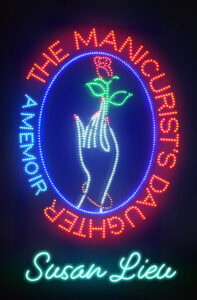
Written by Stephen Hong Sohn
Edited by Corinna Cape
So, I’ve been a little bit on a memoir kick as of late, and I saw Susan Lieu’s The Manicurist’s Daughter (Celadon Books, 2024) and tackled it while I was in Washington DC over the last year. The official marketing blurb gives us these tidbits: “An emotionally raw memoir about the crumbling of the American Dream and a daughter of refugees who searches for answers after her mother dies during plastic surgery. Susan Lieu has long been searching for answers. About her family’s past and about her own future. Refugees from the Vietnam War, Susan’s family escaped to California in the 1980s after five failed attempts. Upon arrival, Susan’s mother was their savvy, charismatic North Star, setting up two successful nail salons and orchestrating every success—until Susan was eleven. That year, her mother died from a botched tummy tuck. After the funeral, no one was ever allowed to talk about her or what had happened. For the next twenty years, Susan navigated a series of cascading questions alone—why did the most perfect person in her life want to change her body? Why would no one tell her about her mother’s life in Vietnam? And how did this surgeon, who preyed on Vietnamese immigrants, go on operating after her mother’s death? Sifting through depositions, tracking down the surgeon’s family, and enlisting the help of spirit channelers, Susan uncovers the painful truth of her mother, herself, and the impossible ideal of beauty. The Manicurist’s Daughter is much more than a memoir about grief, trauma, and body image. It is a story of fierce determination, strength in shared culture, and finding your place in the world.”
One of the main takeaways from this book is the endurance of grief. For Lieu, the sudden death of her mother from plastic surgery becomes a void that impacts her family for decades. Indeed, it is clear from Lieu’s memoir that her mother was the congealing force not only behind her nuclear family but her broader extended family as well. The complications of her mother’s death also influence the trajectory of their family business. Having built a thriving nail salon business, her mother enabled her immediate and extended families to have a measure of financial security as refugees and immigrants. In the wake of her death, the family struggles to evolve the business, and Lieu must soon make her way through the world with limited finances even while still pushing herself to succeed. One of the most interesting aspects of the memoir is when Lieu begins to explore the importance of performance and art for her life. She makes forays into the world of theater with solo shows that begin to give her an outlet to explore her complicated, intersectional background. The concluding arc of the memoir is perhaps the most poignant, as Lieu really seeks to dive into her past, especially with respect to the circumstances of her mother’s death. In the process, Lieu comes to terms with the oppressive nature of gendered/racialized beauty standards, while also acknowledging the incredible obstacles that refugees must overcome simply to survive. An arresting work!
Buy the Book Here
 comments
comments
A Review of Sumni’s Firebird (HarperAlley, 2023)
![[personal profile]](https://i.gr-assets.com/images/S/compressed.photo.goodreads.com/hostedimages/1491408111i/22407843.png) ccape
ccape
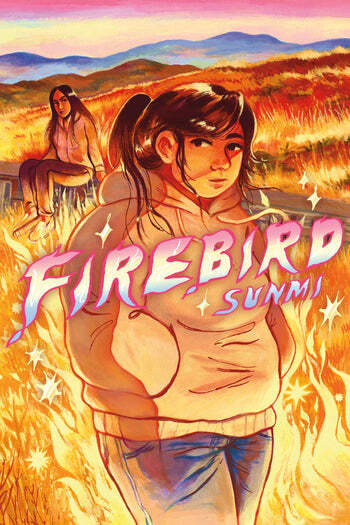
Written by Stephen Hong Sohn
Edited by Corinna Cape
I was sad to see that Sumni’s Firebird (HarperAlley, 2023) didn’t have too many reviews for it, but at least we’ll remedy that issue by covering it here at AALF! Let’s let the official marketing description give us some key contexts: “Sunmi’s gorgeous two-color teen graphic novel debut examines the power of resilience and reinvention, following the lives of Caroline and Kim, two queer, Asian American teenagers growing up in the suburbs of the San Francisco Bay Area, as they forge an unexpected connection. Caroline Kim is feeling the weight of sophomore year. When she starts tutoring infamous senior Kimberly Park-Ocampo—a charismatic lesbian, friend to rich kids and punks alike—Caroline is flustered…but intrigued. Their friendship kindles and before they know it, the two are sneaking out for late-night drives, bonding beneath the stars over music, dreams, and a shared desire of getting away from it all. A connection begins to smolder…but will feelings of guilt and the mounting pressure of life outside of these adventures extinguish their spark before it catches fire?”
I loved this graphic novel for its streamlined, yet nuanced rendering of burgeoning queer, racialized friendships and relationships. It is Kimberly Park-Ocampo who is the free spirit of the two. Though she comes from a family that is under financially strained times (as a note, I believe that Kimberly is part Filipinx-Korean), she always maintains a positive attitude, especially toward her younger siblings. When Kimberly meets Caroline for the first time, you can tell that Kimberly has the upper hand, but Kimberly’s so down-to-earth that she instantly can make friends with pretty much anyone. Caroline is far more uptight, with a complicated living situation, just like Kimberly, as their fathers are essentially both absent figures. Caroline feels pressure from her mother to perform well in school, but she’s always seeking social outlets and the possibility of romance. Eventually, Kimberly and Caroline begin to bond, with the clear sense that something else might be on the horizon. Sunmi’s expertise is in the understated way she keeps pacing readers toward what will eventually be a satisfying conclusion between these two characters. The art has a cartoon-ish style that I very much appreciated, though at times the cursive writing was a little bit hard to read. This one is certainly a graphic novel I could see myself adopting in a future course of mine. My sibling and I agreed: this work is the type of graphic novel we needed when we were younger so that we could see the complex lives that queer, racialized teenagers could lead and that even romance could be possible.
Buy the Book Here
 comments
comments



